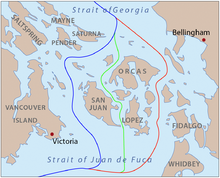Geoffrey Hornby
Knight Grand Cross of the Order of the Bath | |
|---|---|
| Relations | Admiral Sir Phipps Hornby (father) James John Hornby (brother) Edmund Phipps-Hornby (son) |
Hornby went on to be Commander-in-Chief, West Africa Squadron, Commander-in-Chief of the Flying Squadron and then Commander-in-Chief, Channel Squadron. After that he became Commander-in-Chief, Mediterranean Fleet, President of the Royal Naval College, Greenwich and finally Commander-in-Chief, Portsmouth.
Early career

Born the son of Admiral
Hornby had no patron once the Aberdeen ministry came to power in December 1852 and instead cared for his father's estate at Lordington and played no part in the Crimean War.[2] Following a change of government, Hornby became commanding officer of the frigate HMS Tribune on the Pacific Station in August 1858.[2] When he arrived at Vancouver Island with a naval brigade, he found that a unit of American troops was about to take over the San Juan Islands in a dispute known as the Pig War.[3] Hornby used his powers of diplomacy to facilitate a peaceful handover of the islands to the United States.[3]
Hornby became commanding officer of the
Promoted to commodore, he became Commander-in-Chief, West Africa Squadron, with his broad pennant in the frigate HMS Bristol in September 1865.[3] He condemned the independent rulers of West Africa for continuing to supply slaves when all civilised countries except Brazil had abolished slavery.[3]
Senior command

Promoted to

Hornby became
Promoted to full
Family
In 1853 Hornby married Emily Frances Coles (sister of Captain Cowper Coles), with whom he had three sons and two daughters.[1] One of his sons, Edmund Phipps-Hornby, a major in the artillery, won the Victoria Cross in South Africa in 1900; another, Robert Hornby, became an admiral in the Royal Navy.[1]
References
- ^ doi:10.1093/ref:odnb/13786. Retrieved 30 December 2014. (Subscription or UK public library membershiprequired.)
- ^ a b c d e f g Heathcote, p. 118
- ^ a b c d e f g h i j Heathcote, p. 119
- ^ "No. 23456". The London Gazette. 5 January 1869. p. 50.
- ^ "No. 24169". The London Gazette. 8 January 1875. p. 79.
- ^ a b Heathcote, p. 120
- ^ Lambert, p. 276
- ^ Lambert, p. 265
- ^ Wilson, p. 498
- ^ "No. 24613". The London Gazette. 13 August 1878. p. 4581.
- ^ "No. 24734". The London Gazette. 17 June 1879. p. 3967.
- ^ "No. 25542". The London Gazette. 22 December 1885. p. 6191.
- ^ "No. 25551". The London Gazette. 22 January 1886. p. 329.
- ^ "No. 25816". The London Gazette. 15 May 1888. p. 2766.
- ^ "No. 26601". The London Gazette. 22 February 1895. p. 1066.
Sources
- Heathcote, Tony (2002). The British Admirals of the Fleet 1734 – 1995. Pen & Sword Ltd. ISBN 0-85052-835-6.
- Lambert, Andrew (2008). Admirals. London: Faber & Faber. ISBN 978-0571231577.
- Wilson, Ben (2013). Empire of the Deep: The Rise and Fall of the British Navy. W&N. ISBN 978-0297864080.
External links
- Chisholm, Hugh, ed. (1911). . Encyclopædia Britannica. Vol. 13 (11th ed.). Cambridge University Press. p. 708.
- The Dreadnought Project: Geoffrey Hornby
- William Loney Career History
